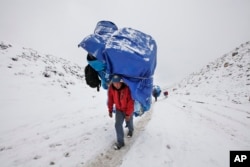Hundreds of colorful tents dotting the base camp at Mount Everest bustle with activity as scores of cooks, porters, sherpa mountain guides and medical teams prepare for the arduous trek up jagged, snow-clad paths to the world’s highest peak.
Over 200 climbers have scaled the daunting mountain in the past 10 days, sending a wave of optimism through Nepal, where the peak is not just a challenge for mountaineers, but crucial to sustaining the economy and the livelihoods of residents in mountain-hugging villages.
More climbers are waiting to take advantage of the good weather, which is expected to last until monsoon rains arrive in June.
After two years of climbing were wiped out by disasters, the number who have showed up this summer to conquer the peak is the lowest in five years. Only 279 teams have official permits so far.
But the sense of nervousness at the start of the season is slowly fading away and hopes of reviving mountain tourism are soaring as climbers scale the peak.
“Excellent, this year is very excellent. The climate is also in our favor, now weather is normal, not any problem,” beamed Jivan Prasad Acharya, a senior official at the Mountaineering section of the Tourism Department.
Preparations
Setting foot on top of Everest this year became possible after weeks of painstaking preparation to ensure that the route is safe in the wake of last year’s deadly earthquake that rocked the Himalayan ranges.
Ang Tshering Sherpa, the president of the Nepal Mountaineering Association, said the most challenging task was carried out by nine of the country’s most experienced sherpas just below the towering 8,878 meter peak.
“They struggle[d] more than 18 hours to fix the rope at 8,700 meter and above, because there was a lot of accumulation of snow and it was very difficult to find anchor, a stable rock under the snow,” Tshering said.
He said they fixed two lines of ropes — one to go up and one to descend: “It made it safer and that is why a lot of people are going to the summit.”
Last year's tremor triggered a deadly avalanche, killing at least 19 people at base camp. In 2014, the climbing season ended abruptly after 16 guides were killed while crossing a treacherous stretch known as the Khumbu Icefall.
Both disasters raised worries about the stability of mountain trails and soured the mood as angry sherpas refused to guide foreign teams after complaining of being paid a pittance of $3,000 to $5,000 a season for risking their lives.
Those bad memories have not quite gone away. Tika Regmi, of the private agency Adventure Mountain Explore Treks and Expedition, is among the many people who are praying for an uneventful season on Everest.
Trekking permits and mountain expeditions yield millions of dollars in revenue to the poor nation.
Regmi said the government has made efforts to address the concerns of sherpas.
“There is a large number of facilities for our sherpas, such as helicopter evacuation, their treatment and if something goes really bad, we look after their families, their children, such kind of stuff has really increased,” he said.
The risks were again highlighted this year when a Nepalese mountain guide slipped and fell to his death on the nearby Mount Lhotse while fixing ropes to the summit for his Western clients.
Business is down
Regmi admits business is down by about 30 percent, but is satisfied that so many people have showed up, not just to climb Everest, but also to explore other trails and peaks in a country with many tall mountains.
He said many customers, who had offered monetary help in the wake of the earthquake, have responded to their pleas. “We said do not send us money now. Send us your families, your parents, your friends or you come back to visit the country."
The crowds may be back at Everest, but long-term worries about the mountain — which many say is commercially overexploited — linger in the mountaineering community.
Record numbers
In 2013, a record number of 658 climbers scaled the summit, sparking reports of mountaineers actually waiting their turn to stand on the Everest summit. Since the climbing season is short, many climbers make the journey in a single day.
The impact of climate change and global warming is impacting the high Himalayan region, said Tshering, who has grown up in the mountains. He worries that the warming of the base of the ice is resulting in large blocks of ice getting detached from the mountain, increasing the risk of accidents.
“The snows are melting and rock portion appearing, which makes [it] quite tough, but our climbers are very skilled and capable how to tackle such situations,” he said.













